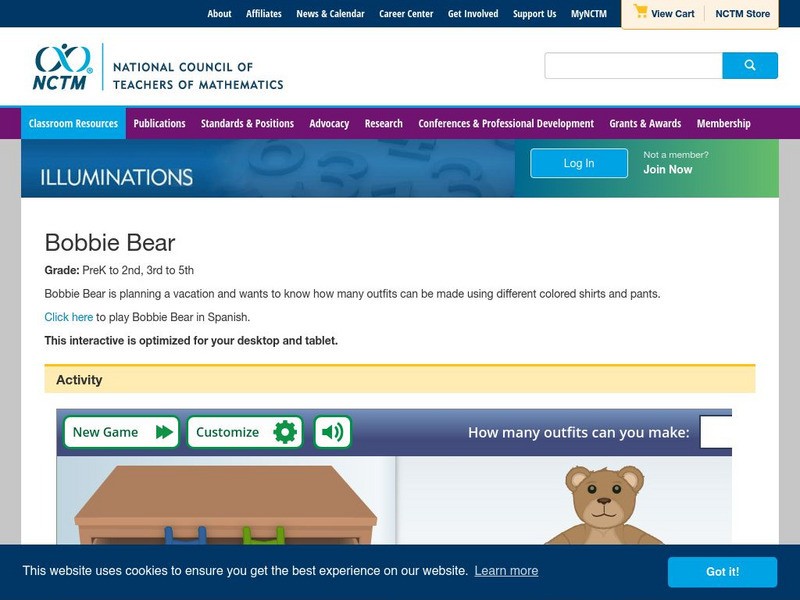Curated OER
Tetrahedral Dice
Put those thinking hats on and look at all the possible outcomes from rolling two different four-sided dice. The challenge in this problem is finding all the combinations when adding and subtracting the numbers from each die and creating...
Scholastic
Study Jams! Combinations
With so many combinations, this colorful video allows your learners to mathematically figure out how many options they have when purchasing t-shirts. One instructional activity teaches how to find out the combinations, and the second...
Scholastic
Study Jams! Tree Diagrams
With so many toppings to chose from, make the ice cream truck combinations a fun math problem that teaches your learners about outcomes. The video introduces a tree diagram that allows your mathematicians to see how to create...
Curated OER
Integrated Algebra Regents Questions: Combinations and Probability
In this combinations and probability worksheet, middle schoolers solve 3 short answer problems. Students draw tree diagrams to represent possible outcomes in a sample space. Middle schoolers determine the probability of an event.
Curated OER
Probability Experiment
Students do an experiment with probability. In this probability lesson, they listen to part of the book G is for Googol: A Math Alphabet Book by David M. Schwartz. They complete 3 probability experiments and check to see how close...
Curated OER
Math Regents Exam Questions: Combinations
In this combinations worksheet, students solve 20 short answer and multiple choice questions. Students determine the number of possible combinations given a word problem.
Curated OER
Probabilities for Number Cubes
Students explore the concept of probability. For this probability lesson, students roll a six-sided number cube and record the frequency of each outcome. Students graph their data using a frequency chart and keep tally marks...
Curated OER
Represent Outcomes
In this possible outcomes worksheet, students analyze a tree diagram of music and theater events. Students solve 6 story problems.
Curated OER
Probability
Seventh graders explore probability. In this probability lesson, 7th graders investigate modern day uses of probability. Students demonstrate probability through an experiment using dice.
Pennsylvania Department of Education
Adding and Subtracting Rational Numbers to Solve Problems
Students explore the concept of probability. In this probability lesson, students use area to determine probability. Students use charts and spinners to help determine the probability of events such as flipping a coin or...
Curated OER
How Many Ways?
For this number combining worksheet, students have 3 boxes and 7 buttons. Students create a chart for all the possible ways the buttons could be placed in the boxes.
Curated OER
Alpha- Bits
In this probability worksheet, students solve 8 word problems that pertain to possible outcomes and probability of drawing alphabet letters from a bag.
Curated OER
Consider the Possibilities
In this math worksheet, students analyze 4 story problems which have questions about possible outcomes. Students answer the questions which involve money, calendar and fractions.
Curated OER
Which is Impossible?
In this math activity, students solve 4 riddles in which 3 out of 4 answers shown could be correct. Students mark the answer that would be impossible.
Curated OER
Which Are Possible?
In this math worksheet, learners solve 4 story problems in which 4 answer choices are given. More than one answer could be correct. Students choose the possible correct answers.
National Council of Teachers of Mathematics
Nctm: Illuminations: Bobbie Bear's Vacation Outfits
Help Bobbie Bear figure out how many outfits he could make with his shirts and pants. He can have up to 5 shirts and 4 pants. Figure out all the possible combinations.
Beacon Learning Center
Beacon Learning Center: Me Too Probability
Students find possible outcomes using tree diagrams in this interactive web lesson.
Beacon Learning Center
Beacon Learning Center: On Stage Probability
Students explore how tree diagrams can display possible outcomes in probability problems through this interactive web lesson.
Beacon Learning Center
Beacon Learning Center: Who Will Probably Come to the Party?
Students use tree diagrams to find possible outcomes and make predictions for probability story problems.
Alabama Learning Exchange
Alex: Probability What Are the Odds?
This instructional activity introduces students to experimental and theoretical probability using spinners and trials with pennies. Students also research careers that involve probability, and create a video presentation. It provides an...
McGraw Hill
Glencoe: Self Check Quizzes 1 Probability of Independent Events
Use Glencoe's randomly generated self-checking quiz to test your knowledge of the probability of independent events. Each question has a "Hint" link to help. Choose the correct answer for each problem. At the bottom of the page click the...
Shodor Education Foundation
Shodor Interactivate: Lesson: Tree Diagrams and Probability
This lesson plan helps students develop tree diagrams and figure probability of events based on diagrams. Lots of resources are available to support teachers and students at this website.
Shodor Education Foundation
Shodor Interactivate: Lesson: Probability and Sports
The Shodor Education Foundation provides this lesson plan. In it, students explore where probability can be applied to professional sports. NCTM standards are listed for this lesson plan.
Oswego City School District
Regents Exam Prep Center: Tree Diagrams
This tutorial demonstrates how tree diagrams are constructed and shows how to calculate the probability of an event using a tree diagram. There are links to a lesson, practice page, and teacher resource pages with useful tips.






















